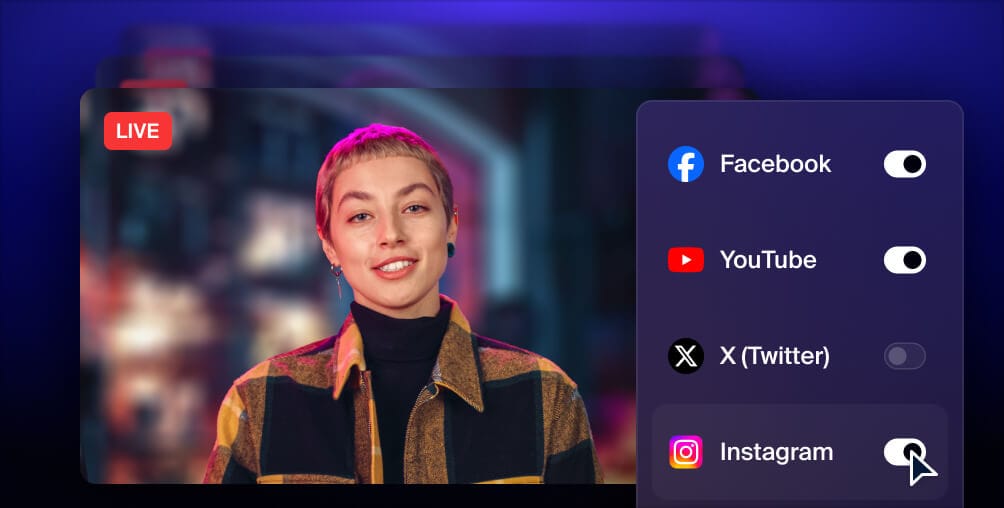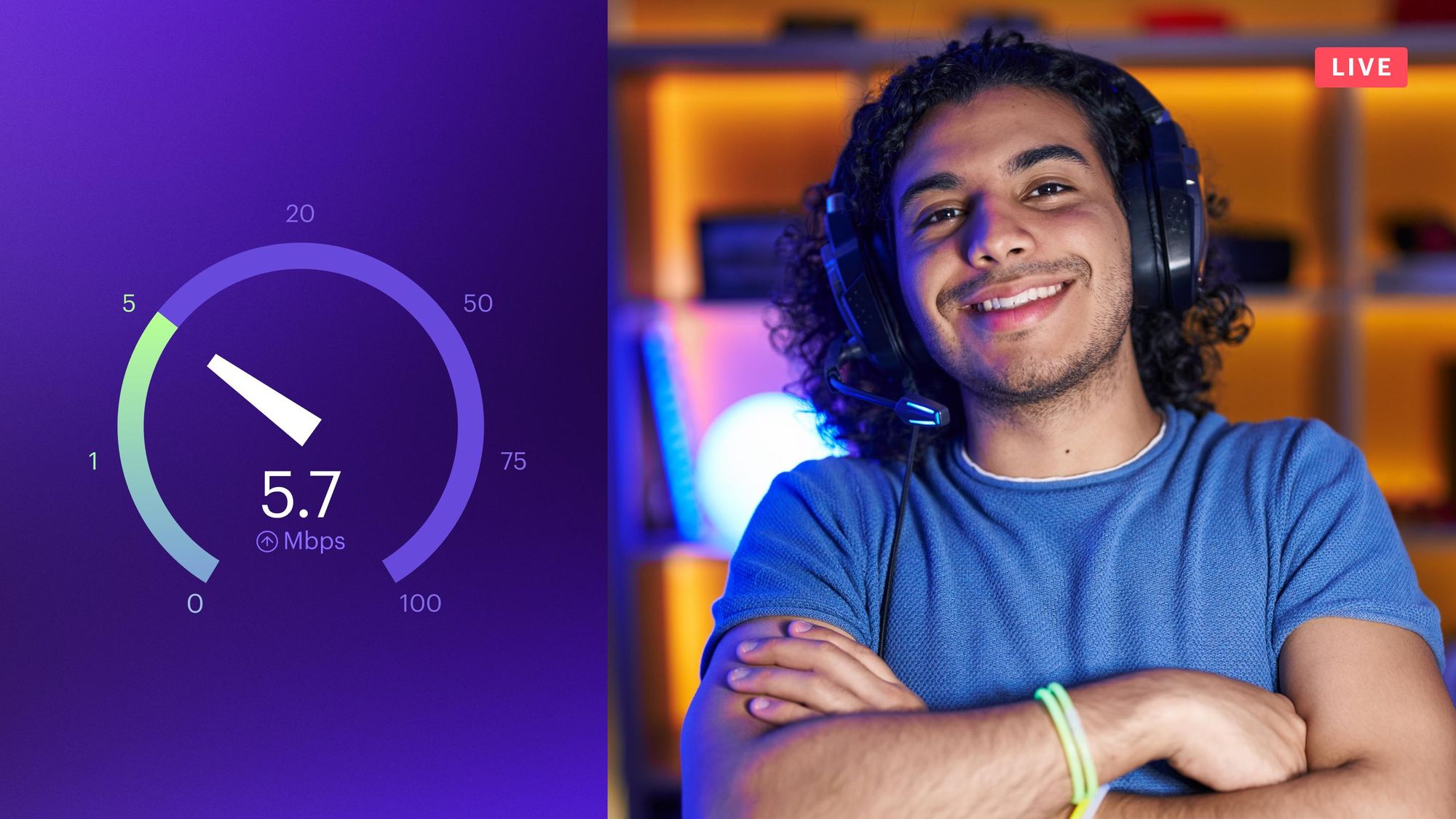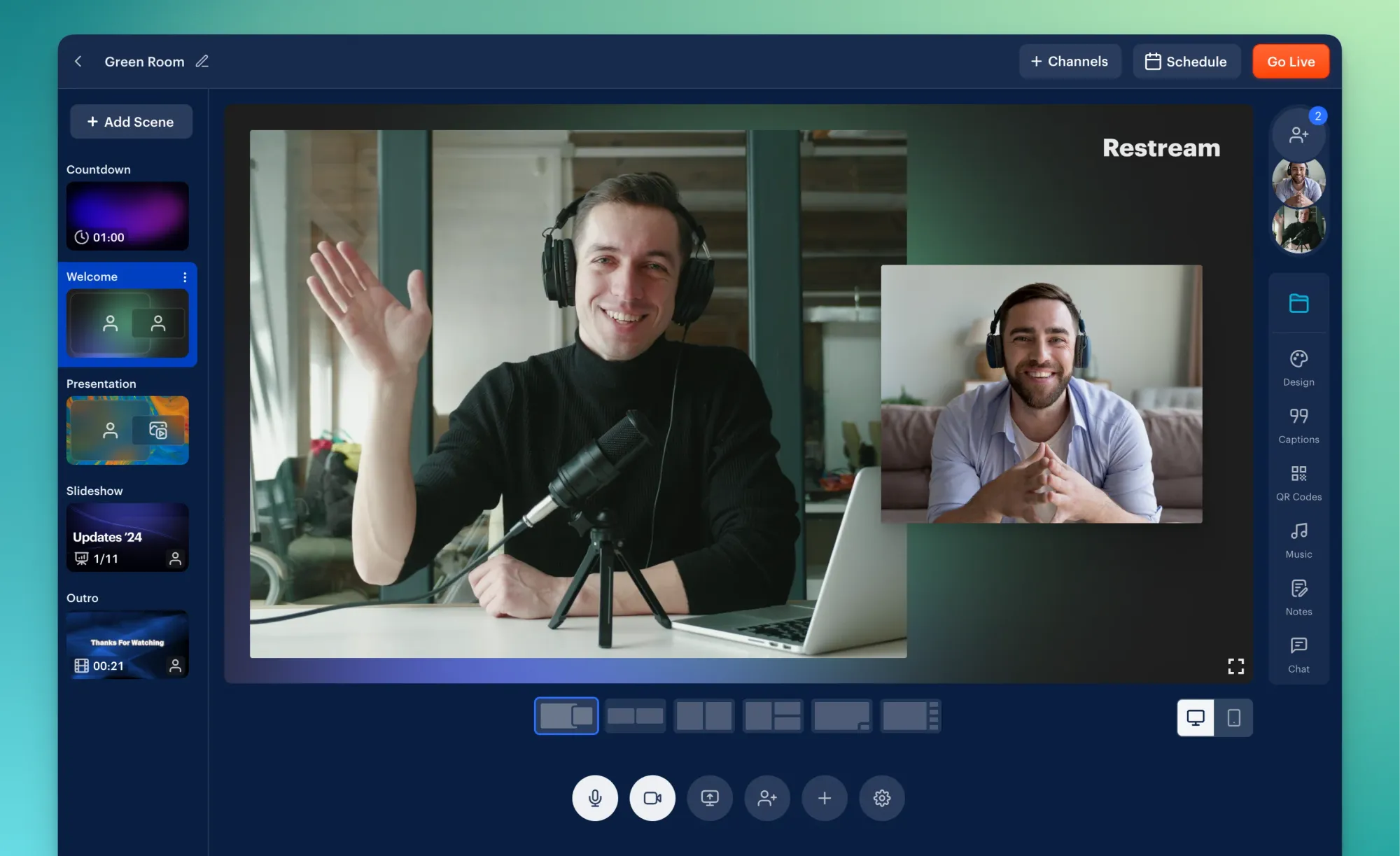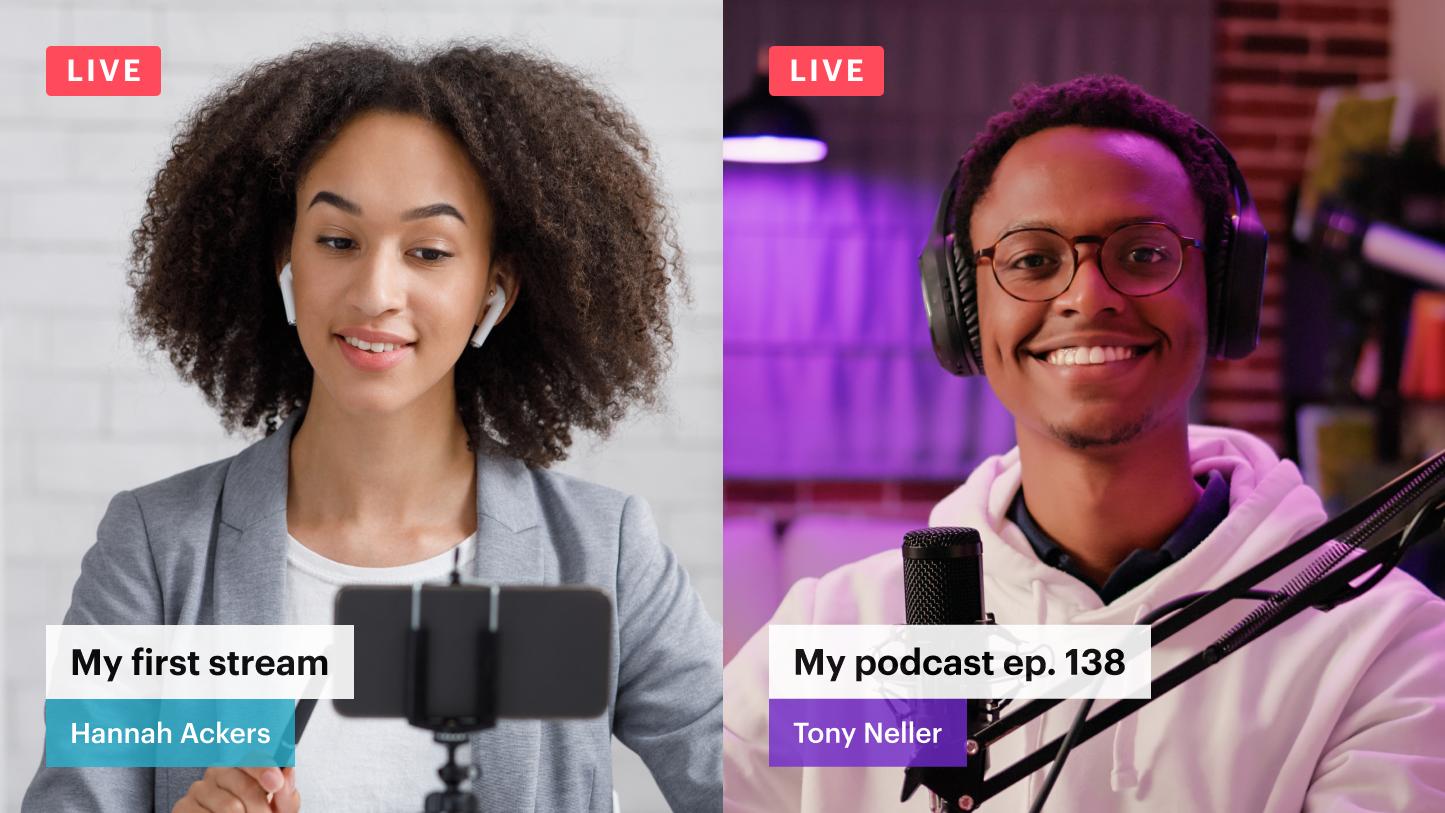To start live streaming, you need a stable internet connection with a good upload speed. But what makes a “good” upload speed? It depends on several factors, including the platform you stream to and the quality of your stream. Let’s dig deeper.
What is download and upload speed?
People consume content online. They seek it out, identify it, and then read, listen or watch it. To be able to do that, their devices need to ingest data, which comes to them in the form of bits. Your internet connection’s download rate describes how many bits of data your computer or device can take in from the internet using that connection. Usually, the rate (also referred to as bitrate) is expressed in millions of bits — or megabits — per second (Mbps).
It’s your connection’s upload rate that matters the most.
When you create content and want to share it online, it’s your connection’s upload rate that matters the most. It’s the same as the download rate; it just works the other way around, describing how many bits of data your computer or device can send to the internet per second. It’s also expressed in Mbps. Data shows that, globally, upload rates are slower than download rates.
What is a good upload speed for streaming?
Streaming live video can take up a lot of bandwidth. Just how much will depend on several factors. Encoding matters, but so does the type of content you want to stream. Platforms play a part, as do the resolution (expressed in pixels, or p) and the frame rate (frames per second, or fps) of your stream.
Let’s say you want to live stream a video of yourself interviewing someone, and you’re deciding where to stream: Facebook, YouTube, Twitch or Kick. Since all these platforms support a live streaming video resolution of 720p, we’ll use the bitrate recommendations from each platform for 720p at 30fps:
- Facebook Live recommends a range between 2,250 and 6,000 Kbps for video, plus a max audio bitrate of 128 Kbps.
- YouTube Live recommends a range between 3,000 and 8,000 Kbps for video, plus 128 Kbps for audio.
- Twitch recommends 3,000 Kbps for video, plus up to 160 Kbps for audio.
- Kick.com supports up to 8,000 Kbps for video but doesn’t have a specific recommendation for 720p at 30fps.
If you’re streaming live video at a resolution of 720p, at 30 frames per second, you’ll upload up to 4,160 kilobits, or 4.16 Mbps, of data per second. So an upload bandwidth of around 4 Mbps should cover you, right?
Not quite. You’ll need to upload up to 4,160 kilobits of data per second constantly. Because upload speeds fluctuate, it’s a good idea to have a 35% to 40% buffer. That puts us at an upload rate of around 5,700 kilobits per second, or 5.7 Mbps. However, if you’re sure your internet connection is stable, a buffer might not be needed. Remember, a stable connection is as important as upload speed.
For various reasons, your ISP’s declared upload bandwidth and the actual upload speed you can achieve with your connection can be very different. That’s why you should always test your upload speed using online speed tests. The number you get from these tests should be up to 5.7 Mbps if you want to stream 720p video at 30 frames per second.
The many variables affecting upload speed requirements
The 5.7 Mbps upload speed for 720p video at 30 frames per second is the upper limit. You can still live stream 720p video with a lower upload speed. If the whole video is a single shot of you talking, 4,000 Kbps might be too high of a bitrate. You’d probably be fine if you reduced it by half.
If, on the other hand, you want to stream video games or events with tons of visual information, 4,000 Kbps is necessary. The faster the pace of the visuals, the higher your bitrate should be. The type of content you stream affects what a good upload speed is for your setup.
Let’s stay with video games. If you’re streaming games with fast-paced action, you should ensure that your viewers see what’s going on as clearly as possible. You might want to stream at more than 30 frames per second.
However, more frames per second requires a higher bitrate. For Twitch, it pushes the range for 720p video to 4,500 Kbps. When you factor in these requirements, that’s a 6.2 Mbps upload speed for Twitch if you want to stream 720p video at 60 frames per second. Also, keep in mind that these are just the highest optimal values.
A good upload speed for your live streaming will vary from one platform to another.
Twitch allows up to 1080p video at 60 frames per second. You’ll need an upload speed of up to 7.4 Mbps to support that.
YouTube supports 4K live streaming at 60 frames per second. It recommends a bitrate in the range of 10,000 to 40,000 Kbps. You’d need an upload speed of 54 Mbps to pull that off.
Finally, your competitors might affect your upload speed requirements. Twitch and YouTube are crowded with streamers trying to use the platforms to generate income. If you’re streaming too, you can’t afford to fall behind on video quality. Better quality requires higher upload speeds, so the competition will eventually push you to increase your upload rate.
What should my upload speed be?
With all these variables in mind, the question isn’t so much “What’s a good upload speed?” as it’s “What upload speed should I aim for in my situation?”.
Which bitrates and corresponding upload rates do the four major streaming platforms advise streamers to use? We’ll segment by platform, resolution, and frames per second, where applicable.
- For 720p video at 30 fps, the bitrate should be 1,500-4,000 Kbps. That requires an upload speed of 2 to 5.4 Mbps.
- For 720p video at 60 fps, the bitrate should be 2,250-6,000 Kbps. That requires an upload speed of 3 to 8 Mbps.
- For 1080p video at 30 fps, the bitrate should be 3,000-6,000 Kbps. That requires an upload speed of 4 to 8 Mbps.
- For 1080p video at 60 fps, the bitrate should be 4,500-9,000 Kbps. That requires an upload speed of 6 to 12 Mbps.
Twitch
- For 720p video at 30 fps, the bitrate should be 3,000 Kbps. That requires an upload speed of 5 Mbps.
- For 720p video at 60 fps, the bitrate should be 4,500 Kbps. The required upload speed is 6.2 Mbps.
- For 1080p video at 30 fps, the bitrate should be 4,500 Kbps. The required upload speed is 6.2 Mbps.
- For 1080p video at 60 fps, the bitrate should be 6,000 Kbps. The required upload speed is 7.4 Mbps.
YouTube
- For 720p video at 30 fps, the bitrate should be 3,000 to 8,000 Kbps. The required upload speed is 4-10.8 Mbps.
- For 720p video at 60 fps, the bitrate should be 3,000 to 8,000 Kbps. The required upload speed is 4-10.8 Mbps.
- For 1080p video at 30 fps, the bitrate should be 3,000 to 8,000 Kbps. The required upload speed is 4-10.8 Mbps.
- For 1080p video at 60 fps, the bitrate range is 4,000 to 10,000 Kbps. The required upload speed is 5.4-13.5 Mbps.
- For 1440p video at 30 fps, the bitrate range is 5,000 to 25,000 Kbps. The required upload speed is 6.7-33.7 Mbps.
- For 1440p video at 60 fps, the range is 6,000 to 30,000 Kbps. The required upload speed is 8-40 Mbps.
- For 4K video at 30 fps, the range is 8,000 to 35,000 Kbps. The required upload speed is 10.8-47.2 Mbps.
- For 4K video at 60 fps, the range is 10,000 to 40,000 Kbps. The required upload speed is 13.5-54 Mbps.
Note that the numbers for YouTube are based on H.265 streaming. The recommended bitrates for H.264 are lower.
Kick
- For 1080p video at 60 fps, the bitrate range is 1,000-8,000 Kbps. The required upload speed is 1.3-10.8 Mbps.
Kick doesn’t provide bitrate recommendations for different video resolutions and frame rates. The maximum resolution is 1080p, the max frame rate is 60, and the max bitrate allowed is 8,000.
As you can see, YouTube offers the highest-quality live streaming. Facebook is the most accessible, while Twitch is still the gamer’s haven.
How to increase your upload speed
Calculating your desired upload speed is one thing, but getting access to that speed is something completely different.
The upload speed you can achieve depends on the service packages your ISP offers. For residential users, the download speed will always be higher than the upload speed. The best way to get symmetry between the two is to sign up for a business-level service if possible. It will guarantee you the ISP’s declared upload speed at any time. This, in turn, provides stability and reliability to ensure smooth live streams.
So, the first step in obtaining a good upload speed for streaming is to switch to an ISP that offers the speed you need. Be prepared to pay more for more speed, though. Also, make sure you ask around about the quality of their service.
If you’re stuck with a provider that offers suboptimal speeds, you can still do a couple of things to improve your situation:
- Get a wired connection. Your Wi-Fi might be great when it comes to watching YouTube videos on your smartphone but when live streaming, a wired connection with an ethernet cable is better. It gives you less interference and more stability, which leads to better stream quality.
- Remove excess devices from your network. You don’t want a crowded internet connection when you start streaming. Don’t let other devices hog your upload speed, and disconnect them from your network or turn off their Wi-Fi capabilities during your stream.
- Close excess programs and apps on your computer. The only thing that should be uploading when you stream is your streaming software. Peer-to-peer networking has probably ruined its fair share of live streams, so wait until you’re off the air.
- Remove malware and use ad blockers and privacy tools. Malware, ads and online tracking can use up some of your upload bandwidth. Remove, stop or block any of these speed-leeching programs.
- Use up-to-date software and hardware. Old drivers can slow your computer down, and old modems can bottleneck your upload speed. Make sure your hardware and software are up to the task of streaming live video.
- Use cloud-based multistreaming. Multistreaming, or streaming live to several platforms at the same time, is incredibly useful for content creators. It helps reach new audiences, saves time, and offers great tools from various platforms. Unfortunately, it can also be demanding on your CPU and bandwidth. To deal with it, use a cloud-based multistreaming service like Restream Studio to bear some of that load.
How to stream with a low upload speed
With Restream's Upload & Stream feature, you can bypass the upload speed inconveniences. How? Our feature allows you to upload your pre-recorded videos, schedule them, and set them to go live later as if they were regular streams. With this method, your upload speed doesn’t matter. After you upload your video, Restream will broadcast it at the scheduled time automatically, so you don’t even have to be online.
Bonus tip: Thanks to our multistreaming technology, you can schedule and live stream your pre-recorded content to top platforms, like YouTube, Facebook, X (Twitter), Twitch and more, all at the same time.

Get more views with multistreaming
Reach more people, and meet viewers where they like to watch. Live stream to YouTube, Instagram, Facebook, Twitch, X, TikTok, LinkedIn, and more at once.
Recommended upload speeds for streaming by use case
One big factor to consider in determining your required streaming upload speed is the type of content you’re broadcasting. Gamers probably require more Mbps than talk show hosts. Here are content-specific recommendations for upload speeds:
- Gaming: Live streaming gameplay asks for more Mbps than most other types of content. Games are highly graphical, which means your internet connection has to work harder to get the content to your viewers. The ideal upload speed for gaming streamers is between 6 and 8 Mbps.
- Sports: If you want to broadcast a sporting event live, you should aim for the highest resolution possible. People are used to watching sports on traditional TV, so they’ll be expecting high quality. Your number of viewers will factor into your required upload speed, with more people tuning in meaning more Mbps. You’ll need a minimum of 5.6 Mbps but closer to 11 Mbps would be ideal.
- Education: The required Mbps for online classes varies by the type of class. For a standard, academic lecture, you don’t need a very high resolution or frame rate, so you can get away with a 1 Mbps upload speed. If you’re streaming a class where visuals are more important, like a fitness class, then you should try to have a higher resolution and aim for 4 to 5 Mbps.
- Places of worship: If you want to stream services from your church or place of worship in full high definition (1080p), then you should have at least a 3.8 Mbps upload speed. If you lower the resolution to high definition (720p), you can probably get away with 2 Mbps. Your church might broadcast music performances sometimes too, which requires a higher resolution for better stream quality. For this kind of live video, you’ll want an upload speed between 2.2 and 5.1 Mbps.
- Music and concerts: It’s common for online concerts or music festivals to have a higher stream resolution, especially if there’s an admission fee to watch. If viewers are paying to see your content, you shouldn’t compromise on quality. For a musical performance in 1080p at 60fps, you’ll need 5.6 Mbps at a minimum. Aim for between 7 and 8 Mbps as the ideal, however.
- Marketers: Marketers stream all kinds of content, from product launches to industry interviews. If you’re streaming a big launch event, you’ll want a higher-quality video and about 5.6 Mbps. For smaller streams, like a one-on-one interview or a product demonstration, you can get away with between 2.2 and 5.1 Mbps.
FAQs
What is upload speed?
Upload speed is how quickly you can send data from your computer or device to another device or server over the internet. You upload data when you live stream a video, add files to your cloud storage, or make video calls. Internet service providers usually allow much faster download speeds than upload speeds.
What is a good upload speed for Twitch streaming?
A good upload speed for Twitch streaming is between 5 Mbps and 7.4 Mbps. The exact speed you need depends on which resolution and frame rate you stream with, as well as the type of content you’re streaming.
What upload speed do I need to stream at 1080p and 60fps?
The upload speed for a 1080p stream at 60fps is between 7.4 Mbps and 11 Mbps, depending on which platform you stream to and what kind of content you’re streaming.
What is a good upload speed for YouTube streaming?
A good upload speed for YouTube streaming is between 2 Mbps and 61.5 Mbps. YouTube offers the widest range of resolution and frame rate options of all streaming platforms, so you’ll need to choose these settings first before deciding what a good upload speed is.
What is a good upload speed for gaming?
Typically, an upload speed of 5-10 Mbps is plenty for gaming. The best speed depends on several factors, such as what type of game it is, the platform you’re playing on, and whether you have to connect online to play. If you’re chatting live with other players while you play the game, that will also affect your needed upload speed.
Is a 30 Mbps upload speed good for streaming?
For streaming on most platforms, you really only need between 2 Mbps and 15 Mbps maximum. If you want to stream in 4K at 60 frames per second (which is only available on YouTube), then you might need 30 Mbps.
Wrap-up
As a live video streamer, the quality of your content will depend on the quality of your broadcast. That’s a fact. You can have the best skills in the most popular games, the best banter, or the greatest sense of humor. But if people can’t see and hear you well, they’re not going to stick around to watch your stream. Upload speeds factor significantly into broadcast quality.
Remember, you shouldn’t go for the highest possible upload speed by default. You only need it if you’re planning to stream at a very high bitrate. A good upload speed is the one that’s appropriate for your goals.







